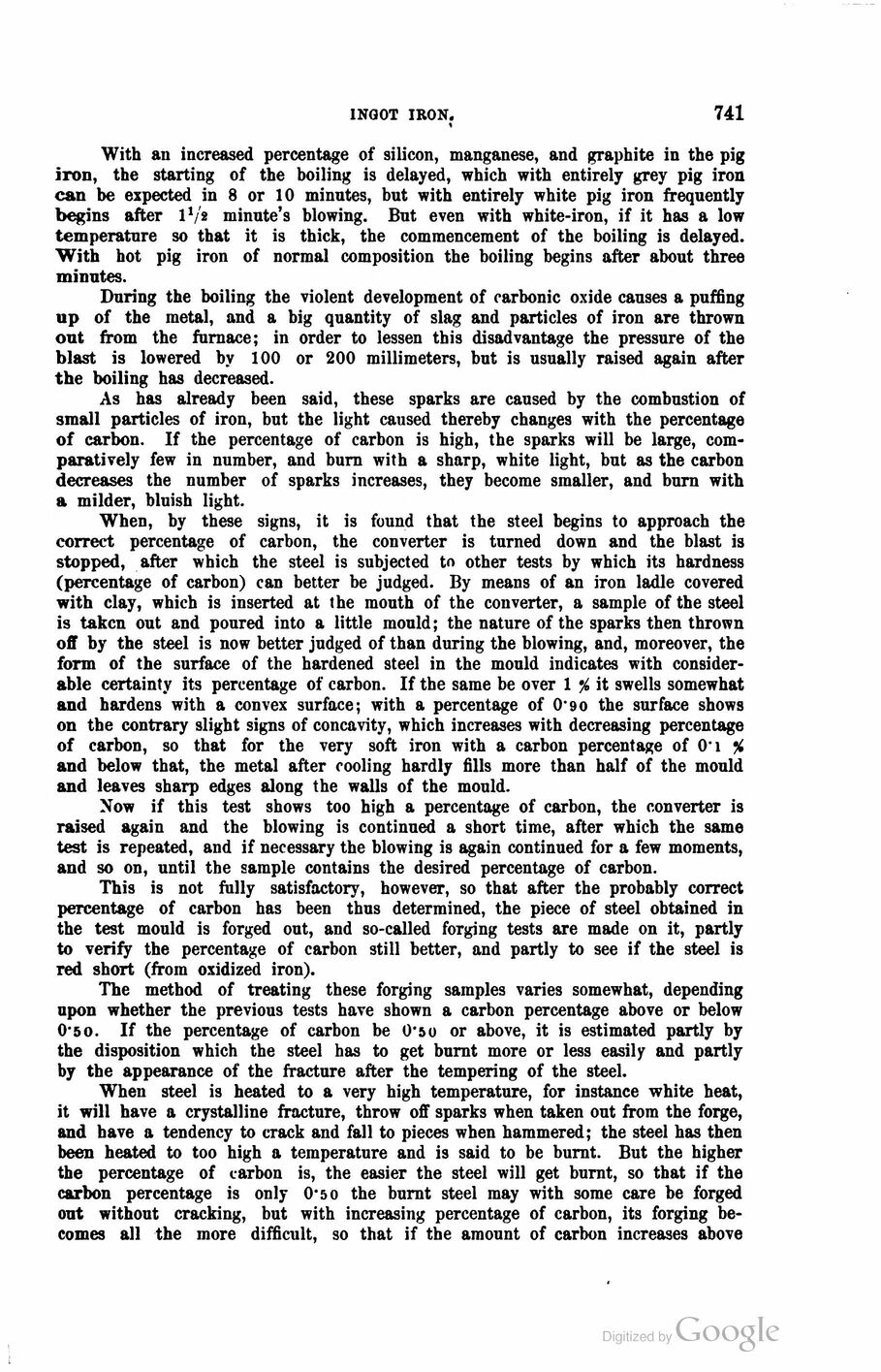
Full resolution (JPEG) - On this page / på denna sida - Second part - IX. Mining Industry and Metal Production - 2. The Iron and Steel Industry. By the late Prof. J. G. Wiborgh - Ingot iron (Steel)

<< prev. page << föreg. sida << >> nästa sida >> next page >>
Below is the raw OCR text
from the above scanned image.
Do you see an error? Proofread the page now!
Här nedan syns maskintolkade texten från faksimilbilden ovan.
Ser du något fel? Korrekturläs sidan nu!
This page has never been proofread. / Denna sida har aldrig korrekturlästs.
wrought iron.
741
With an increased percentage of silicon, manganese, and graphite in the pig
iron, the starting of the boiling is delayed, which with entirely grey pig iron
can be expected in 8 or 10 minntes, but with entirely white pig iron frequently
begins after 11/’s minute’s blowing. But even with white-iron, if it has a low
temperature so that it is thick, the commencement of the boiling is delayed.
With hot pig iron of normal composition the boiling begins after about three
minutes.
During the boiling the violent development of carbonic oxide causes a puffing
up of the metal, and a big quantity of slag and particles of iron are thrown
out from the furnace; in order to lessen this disadvantage the pressure of the
blast is lowered by 100 or 200 millimeters, but is usually raised again after
the boiling has decreased.
As has already been said, these sparks are caused by the combustion of
small particles of iron, but the light caused thereby changes with the percentage
of carbon. If the percentage of carbon is high, the sparks will be large,
comparatively few in number, and burn with a sharp, white light, but as the carbon
decreases the number of sparks increases, they become smaller, and burn with
a milder, bluish light.
When, by these signs, it is found that the steel begins to approach the
correct percentage of carbon, the converter is turned down and the blast is
stopped, after which the steel is subjected to other tests by which its hardness
(percentage of carbon) can better be judged. By means of an iron ladle covered
with clay, which is inserted at the mouth of the converter, a sample of the steel
is taken out and poured into a little mould; the nature of the sparks then thrown
off by the steel is now better judged of than during the blowing, and, moreover, the
form of the surface of the hardened steel in the mould indicates with
considerable certainty its percentage of carbon. If the same be over 1 % it swells somewhat
and hardens with a convex surface; with a percentage of 0’9o the surface shows
on the contrary slight signs of concavity, which increases with decreasing percentage
of carbon, so that for the very soft iron with a carbon percentage of O i %
and below that, the metal after cooling hardly fills more than half of the mould
and leaves sharp edges along the walls of the mould.
Now if this test shows too high a percentage of carbon, the converter is
raised again and the blowing is continued a short time, after which the same
test is repeated, and if necessary the blowing is again continued for a few moments,
and so on, until the sample contains the desired percentage of carbon.
This is not fully satisfactory, however, so that after the probably correct
percentage of carbon has been thus determined, the piece of steel obtained in
the test mould is forged out, and so-called forging tests are made on it, partly
to verify the percentage of carbon still better, and partly to see if the steel is
red short (from oxidized iron).
The method of treating these forging samples varies somewhat, depending
upon whether the previous tests have shown a carbon percentage above or below
0*5o. If the percentage of carbon be 0*5o or above, it is estimated partly by
the disposition which the steel has to get burnt more or less easily and partly
by the appearance of the fracture after the tempering of the steel.
When steel is heated to a very high temperature, for instance white heat,
it will have a crystalline fracture, throw off sparks when taken out from the forge,
and have a tendency to crack and fall to pieces when hammered; the steel has then
been heated to too high a temperature and is said to be burnt. But the higher
the percentage of carbon is, the easier the steel will get burnt, so that if the
carbon percentage is only O’so the burnt steel may with some care be forged
out without cracking, but with increasing percentage of carbon, its forging
becomes all the more difficult, so that if the amount of carbon increases above
<< prev. page << föreg. sida << >> nästa sida >> next page >>